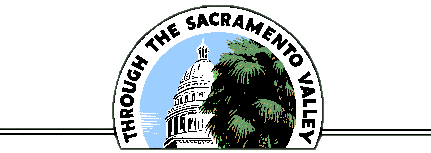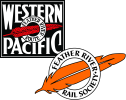CHICO AND ITS STREETCAR LINES
The City of Chico was both the beginning and the end of Sacramento Northern's electric streetcar operations in more ways than one. It was at Chico that the first of the electric lines that were to become the SN was built. It was also the scene of the line's last regular passenger service.
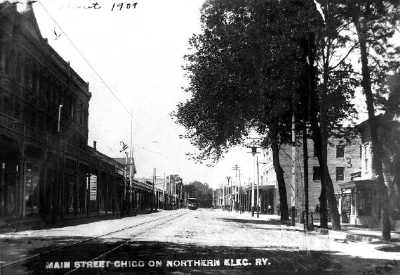
Chico's original streetcar line was the Chico Electric Railway. This line was originally proposed in 1903 by officers of the Diamond Match Company to provide transportation to their huge plant in the Barber neighborhood just outside town. When incorporated in 1904, the directors were instead officers of the California Gas & Electric Company (later Pacific Gas & Electric Company). Although Diamond Match did not control the line, there was a close association with the railroad for many years. Diamond Match crews helped build the electric line, and many of the streetcar line's administrators had connections with Diamond Match.
The original main track ran from Chico Vicino near the northern city limits along The Esplanade in a southeasterly direction, then along Main Street to 5th. At 5th Street the track turned south for one block to Broadway. From here the track again continued to the southeast along Broadway to 16th Street. Then it turned northeast along 16th street to Mulberry Street. At Mulberry the track again jogged southeast and ran for a few blocks to a terminus at 22nd Street in the district known as Chapmantown.

The city was also served by two important branch lines. One branch left the mainline at 2nd and Main Streets, running southwest for four blocks to Chestnut Street. Here it turned southeast and followed Chestnut to the Diamond Match plant at Barber, about 15 blocks. A second branch headed southeast from the corner of 5th Street and Broadway, crossed the Chestnut Street line, and extended to the Southern Pacific depot, a total of about eight blocks. Total length of the streetcar lines under Chico Electric Railway ownership was about 5.5 miles.
Although the trolley line was planned to open on Christmas Day, 1904, the first cars did not operate until the 27th. Regular service began on January 2, 1905. Service was covered with four new double-truck streetcars built by the St. Louis Car Company: numbers 51 and 52 were open bench cars, while numbers 21 and 22 were Los Angeles-type cars with open sections on each end, and a closed section in the middle. All cars were operated with a motorman and a conductor, who were armed to protect the fares from theft. Power at 600 volts DC came from a generator at the Diamond Match plant, and a modest car barn and shop were also built there.

The Chico Electric Railway operated for less than a year before being folded into a much greater scheme. The Northern Electric Railway was incorporated on June 14, 1905, with plans for a major interurban line linking Chico and other important nearby towns with Sacramento. Local millionaire Henry Butters was president and major stockholder, but once again, most of the directors were connected with what was to become Pacific Gas & Electric Company.
The NERY made many changes to the trackage throughout Chico. The most important was to extend their interurban line from 20th Street along Park Avenue and Main Street and Park Avenue to connect with the streetcar line at 5th street. A new carbarn, shops and freight yard were built in the Chapmantown neighborhood near 20th Street The carbarn and power house at the Diamond Match plant were closed in 1906 when the new shops went into operation. The neighborhood adjacent to the new shops was later renamed Mulberry. A combination trolley/interurban depot was built at First and Main Streets on the edge of the downtown area. Part of the route along Main Street was double-tracked. Plans to extend the double-track to Chico Vicino were dropped after objections by local residents.
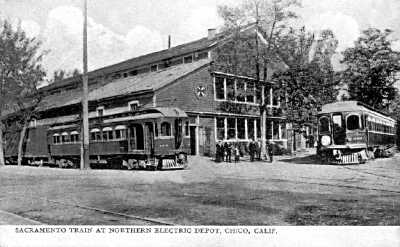
The NE also added four rather used streetcars to the local fleet in 1906. Numbers 70-73 were single-truck California-type cars from the United Railroads of San Francisco. Like Chico Electric 20 and 21, they had open sections at each end with a closed section in the middle. These cars only lasted until 1914, when two were sold to a line in Santa Cruz and the other pair scrapped.
Several important freight customers also located along Main Street and The Esplanade, as well as on the branches, bringing electric locomotives and freight cars onto Chico's otherwise quiet residential streets. A short-lived branch to Hamilton City was added west from the SP station in 1907. Streetcar service on 5th Street was dropped at that time, the schedules being covered by the branch line's local cars.
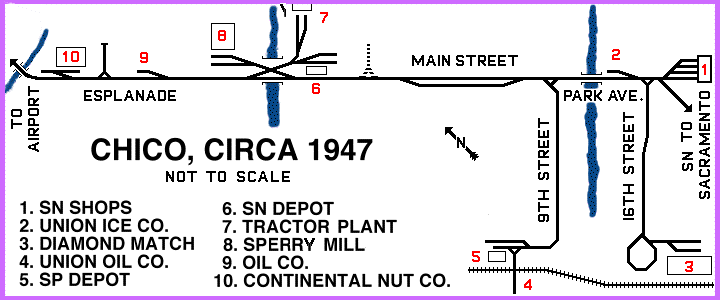
In 1910 the NERY removed the streetcar track along most of 2nd and Chestnut Streets to the Diamond Match plant. A new route south from Broadway along 16th Street directly to the plant was substituted. Diamond Match was also served by their own horse-powered freight railroad along 9th Street, connecting their plant with a log flume on the northeast side of town. In 1912 all this line south of Main Street was taken over by the NERY and a wire was put up. This became the track to the freight interchange with the SP. A connection was made with the Hamilton Branch near the SP depot, and the 5th Street track was removed.

The NERY went out of business June 28, 1918. The bankrupt line was reorganized as the Sacramento Northern Railroad. One of the SNRR's first acts was to purchase two steel Birney safety cars from American Car Company for Chico service. These four-wheeled streetcars, numbered 60 and 61, were operated by only one man. Nine more second-hand cars of this type were later added to the fleet to serve the Yuba City/Marysville and Sacramento lines. Birney 60 seems to have spent most of its life in Chico, with assistance from 62 and 66. Through normal rotation, nearly all the cars operated in Chico during their SN careers.

The older double-truck cars were enclosed and used for local, suburban and branch line service on other parts of the SN system. All four of the double-truck cars later worked on the Yuba City/Marysville streetcar lines, and also served in Sacramento. Numbers 50 and 51 remained streetcars for their entire lives, and were set aside during the 1930s. Number 21 became an suburban car in 1923. Number 22 was rebuilt as a passenger-baggage combination car for the Suisun-Vacaville branch in 1920.
In the 1920s, streetcar lines along Broadway and Mulberry Street to Chapmantown were removed, which left the street car lines pretty much as they would remain until the end of operation. Local track now amounted to about 2.7 miles.

With increasing auto traffic, the streetcars began losing money badly by the late 1920s. Application to the California Railroad Commission to discontinue local service was made by the Sacramento Northern Railway in 1931. The Commission turned down the petition after objections from the city fathers and many local residents. However, headway was cut from 15 to 30 minutes, and cars ran only from 6 a.m. to 6 p.m. with no service on Sundays. Service to Diamond Match was only operated during mornings and afternoons. Although interurban passenger service ended in 1940, Chico's city fathers demanded the streetcars continue to run in exchange for allowing freight service to continue over the city streets.
Both freight and passenger service boomed with gas rationing during World War II. For the next few years, the streetcars again filled with passengers. The municipal airport, just north of the city, was chosen as home for an Army Air Corps training base, provided rail service could be extended to the facility. The city paid for three miles of new track from the end of the streetcar line at Chico Vecino to the base in 1942. This line was operated by the SN, apparently only for freight. When the war ended, the base was returned to local control and was developed as an industrial park. The track was leased to the SN and remained an active freight destination until the end of SN service in Chico.
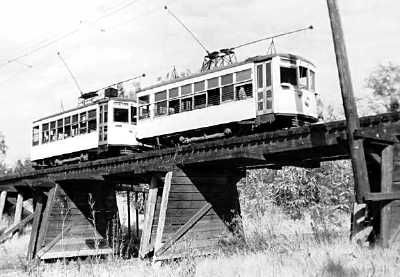
The streetcars finally reached the end of the line in 1947. With the return of prosperity, ridership again fell sharply and deficits rose. The city now had no objection to discontinuing the little Birney cars, which ran almost empty. On December 15, 1947, the last trip was made using car 62. This was the final five cent streetcar fare in California. It was also end of scheduled passenger service on the entire SN system.

The SN's Mulberry Shops, which continued to maintain both their dwindling fleet of electric freight motors, and their new 44-ton General Electric diesels, operated until April 2, 1951. After that date, all work was shifted to the Western Pacific's Jeffrey Shops in Sacramento. With the closure of the shops, the last overhead wire was removed and all remaining track in Chico was dieselized. The carbarn was removed and is now a barn in Glenn County. Most of the yard tracks were lifted. So after 46 years, the last vestiges of electric streetcar operation in Chico quietly disappeared.
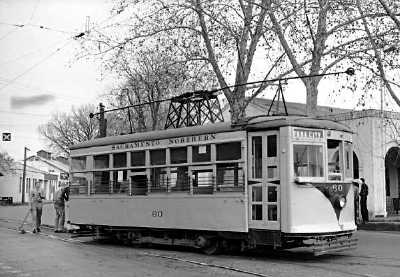
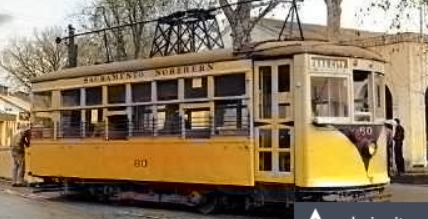
(Colorization done by Waldo Lahr, original photo by Wilbur C. Whittaker photo;
Garth G. Groff collection)
